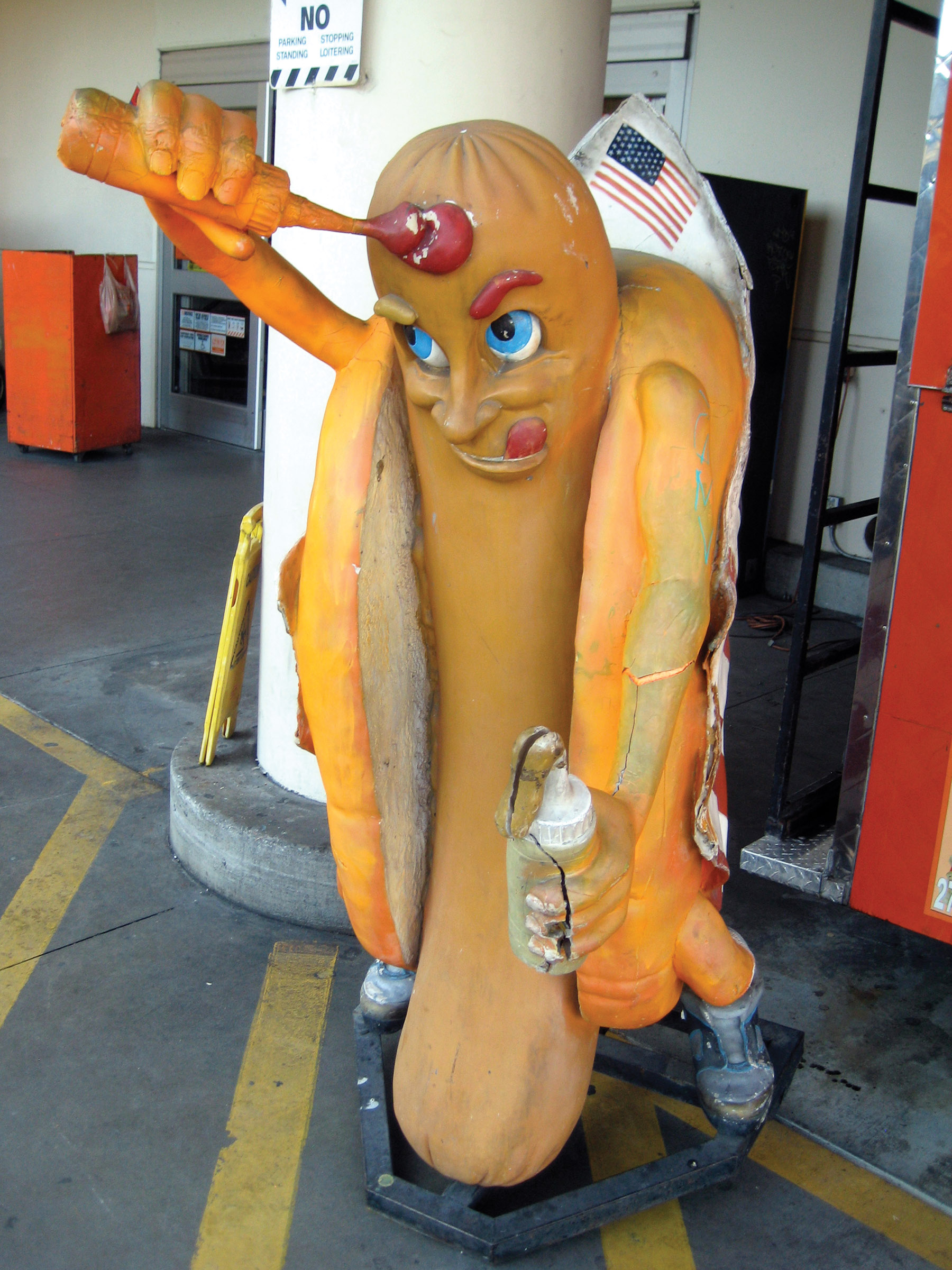
Matt MacFarland, Frankfurter, 2012. Digital photograph. 9 × 12 inches. © Matt MacFarland. Photo courtesy of Vincent Price Museum of Art.
The 2013 MexiCali Biennial, subtitled “Cannibalism in the New World,” was hosted by a Los Angeles-area art museum named for its benefactor, horror film icon Vincent Price. Yet those who read only gore or consumption in the “cannibalistic” works of this group of bloodthirsty artists miss the deeper resonance of the exhibition’s theme. Curators Ed Gomez, Luis G. Hernandez, and Amy Pederson explain in the press release, “The cannibal is a creature that threatens the collapse of identity and ethics, and instills anarchy in the social order.” The curators cite as inspiration a recent book, An Intellectual History of Cannibalism, by Romanian philosopher Catalin Avramescu, who argues the centrality of the cannibal spectre as a foil for Enlightenment Humanism’s argument for rationality. The author cites opinions from natural law philosophers including Hobbes, Locke, Diderot, and Rousseau, as well as the ancient Greeks, whom he describes as having differed on the morality of anthropophagy. Perhaps, as Diderot posits in Avramescu’s introduction, cannibalism is the inevitable result of scarcity when a limited amount of resources is available to a population whose growth is unlimited.1 The resultant anxiety drives the urge to expand into the territory of others, just as the ontological opposition between rational man and savage supports this expansion.
Although Avramescu demonstrates that cannibal practices have been ascribed to a great number of the world’s peoples by Western European philosophers, he indicates that the word and the archetype were established through contact with the New World following Columbus’s discovery of the West Indies. Lascivious descriptions of cannibal tortures abound in the “travel literature” that proliferated as Empire blossomed in the seventeenth and eighteenth centuries. Brazilian poet Oswald de Andrade’s Surrealist-inflected “Cannibalist Manifesto” of 1928 is a call to South American artists to invert this relationship to European thought by embracing anthropophagy as a cultural strategy. His ideas were foundational to the Neo-Concretist artists of the later twentieth century, including Hélio Oiticica, Cildo Mereiles, Lygia Clark, and Lygia Pape, who employed formal and material disruption and recombination as metaphorical devices in their work. They continue to inform artistic strategies used by contemporary artists throughout Latin America and the Diaspora. The artistic tradition of cannibalism is one of transformative appropriation, working within a language of colonial symbols but “savaging” them by processes of reframing, corrupting, consuming, and regurgitating. Andrade wrote, “Carnal at first, this instinct becomes elective, and creates friendship. When it is affective, it creates love. When it is speculative, it creates science. It takes detours and moves around. At times it is degraded. Low cannibalism, agglomerated with the sins of catechism—envy, usury, calumny, murder. We are acting against this plague of a supposedly cultured and Christianized peoples. Cannibals.”2 In this spirit, the Biennial’s curators state, “Cannibalism in the New World was one of the central rationales for colonialism, but MexiCali also proposes it as a path forward towards a new model for avant garde practice” (MexiCali Biennial 2013 press release). It is essential to understand this historical lineage in order to appreciate the complexity with which the exhibition’s artists have explored the topic.
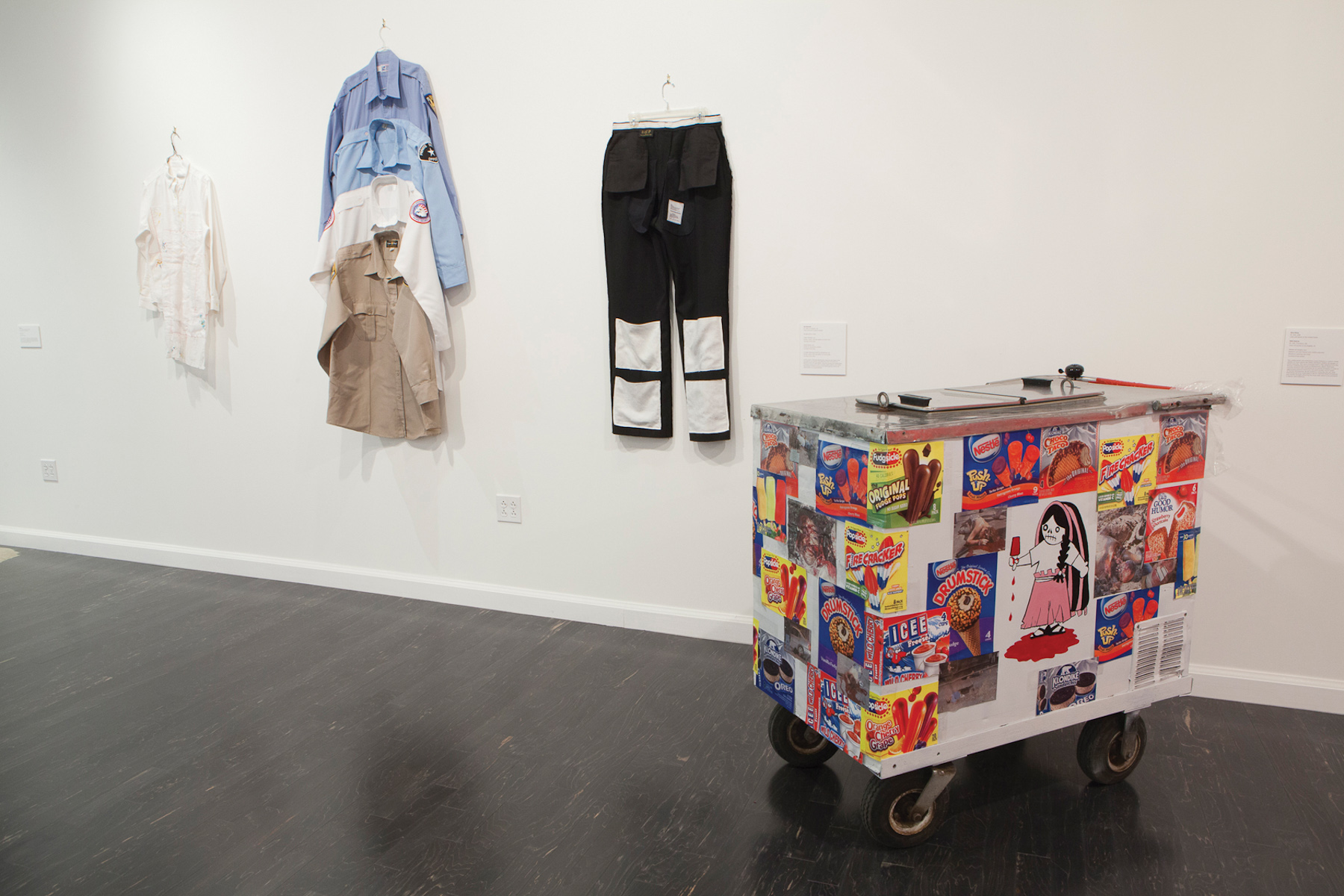
MexiCali Biennial 2013: Cannibalism in the New World, installation view, Vincent Price Museum of Art, January 19–April 13, 2013. Photo courtesy of Vincent Price Museum of Art.
Approaching the entrance, we are met by sandwich boards from Matt MacFarland’s installation Steakation (2012–13), featuring drawings of anthropomorphized, heart-shaped figures made from raw steak. “I want to be inside you!” propositions one. Here, we might be deceived into thinking that it is we the viewers who will be the consumers. MacFarland’s work engages with advertising’s cannibalistic tendencies. He documents instances of promotional foodstuffs throughout the Los Angeles landscape who eagerly anticipate their own consumption, such as a hot dog that determinedly squirts ketchup onto its forehead. Rousseau stated that the desire to consume animals despite their ability to feel pain is indicative of a people’s cruel nature.3 These advertisements suggest that we wish to assuage a collective guilty conscience with respect to our consumption of slaughtered animals, and perhaps for other ramifications of our violent tendencies as a species.
Flavia Monteiro’s Tearing the Leather (2012) suggests we are more likely to be consumed. Monteiro presents a skin of acrylic paint, slung like an animal hide over an acrylic tube but with human-like organs patterning its surface. Evoking Eva Hesse’s works in latex, cheesecloth, and fiberglass, such as Contingent (1969), Monteiro’s object is painting and sculpture, body and sign. It also recalls a gruesome trophy described by Herodotus: “The Scythians make their clothes and even the quivers for their arrows from the skin of their enemies, and drinking cups from their skulls. Some flay their victims and stretch the skin over a frame.”4 From a late Modernist perspective, one could argue that Monteiro’s repositioning of the painted body from a privileged wall position to a debased sculptural one constitutes a kind of violence done to the corpus of figurative painting.
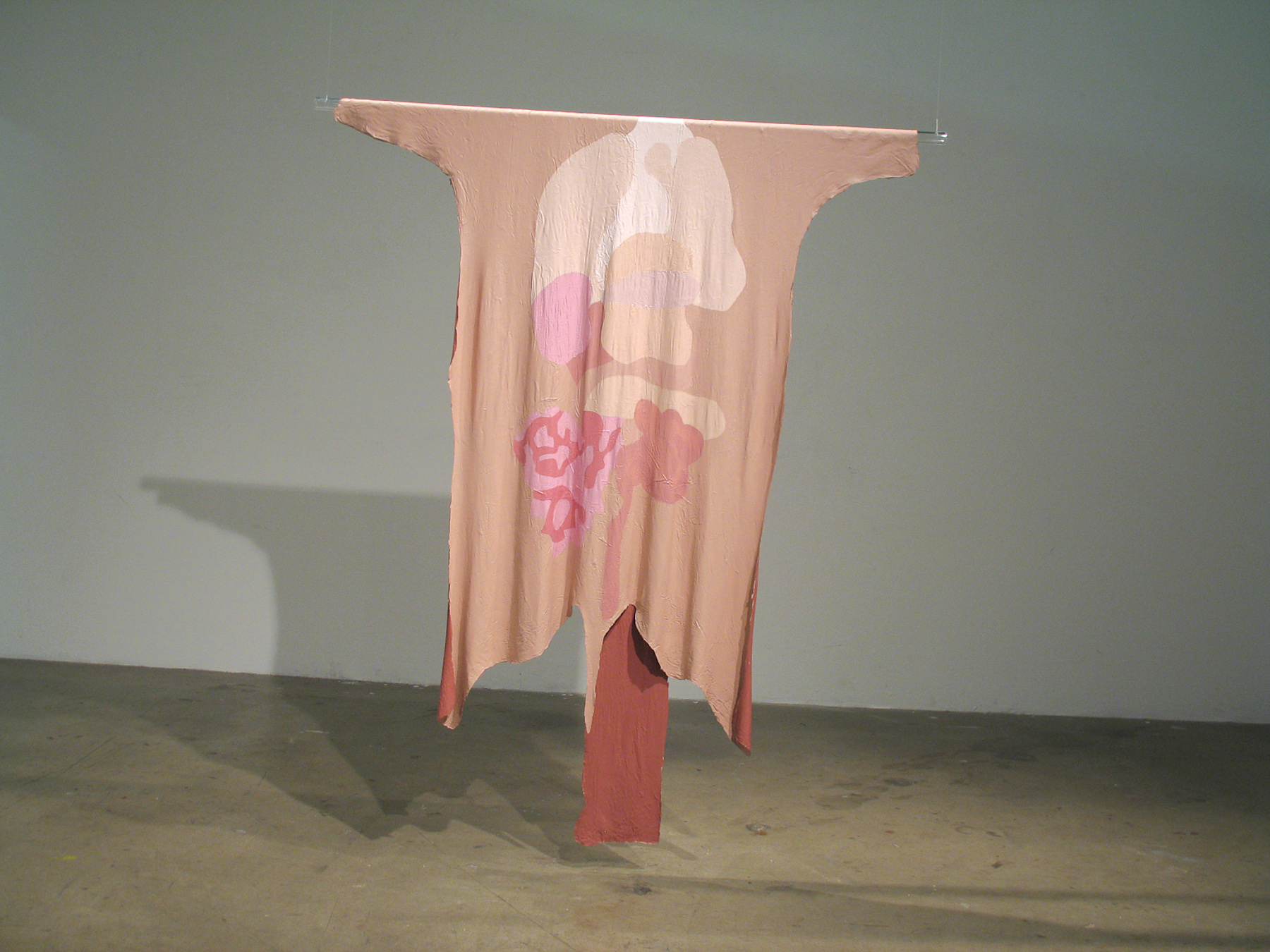
Flavia Monteiro, Tearing the Leather, 2012. Acrylic paint and acrylic tube. © Flavia Monteiro. Photo courtesy of Vincent Price Museum of Art.
Another instructive link with Conceptual art can be found in Devouring Tongues (2012) by Kio Griffith and Carmina Escobar. This long paper scroll documents a year-long sound art composition using voices that was realized over long distance and performed at the exhibition’s opening. The memory of “over 1000 minutes of sound,” transmitted over the Internet across geographical borders, is now mutely encoded into written passages in Japanese and Spanish. Language becomes code and document, its meaning obscured. Humanists argued that language separated humans from animals, and allowed us to build societies. It was an indication, to the religious view, that we were created to dominate and steward the natural world. Contact with New World languages provoked a fear of not understanding, which conflicted with expectations of dominance, leading to a more comforting assignment of the new tongues to the category of animal language. Here, people on opposite sides of the world engage in abstract, bilingual conversation, motivated by poetic rather than communicative meaning.
Sewing is cannibal labor in works by Ana Baranda and Natalia Anciso. In three works dated 2012, Baranda refashions garments owned by her parents to deconstruct their investment in gendered forms of labor (security and housework). Dismembering the clothes that fit their bodies, she digests their years of working to support her. Enlightenment travelers reported cannibal practices and rites that included consumption of a deceased person’s body by his or her children. Some believed that this was the most horrible fate imaginable, while others argued that anthropophagy was justifiable as an “act of piety” in the case of funerary rites.5 Baranda honors her elders by consuming the memories borne by their skins.
Natalia Anciso’s Platicando Con Las Comadres (2012) is a cannibal’s kitchen table, where embroidered tablecloths and delicately drawn samplers detail recent troubles in the United States-Mexico borderlands with a domestic touch. Anciso comes from Rio Grande, Texas, a landscape within United States territory that suffers from many of the same issues of narco-trafficking, kidnapping, and poverty as the adjacent Mexican regions. She applies a range of styles including Mayan huipil textile work and pano arte prison embroidery to her needlework, while her drawings are based on dramatic images from media coverage of the region. Natural law philosophers believed that all societies followed certain universal principles in order to prevent the “struggle of all against all” described by Thomas Hobbes.6 New World tribes were believed to be engaged in such a struggle, and disagreement ensued as to whether a foreign culture’s deviance from natural law principles was a result of inherent difference or of mitigating circumstances. American policy toward the border remains shaped by the premise that lawlessness is due more to regional character than to the disastrous consequences of our drug wars. Anciso acknowledges the families and communities whose pain and perseverance goes unrecognized by the mainstream narrative.
By contrast, Christopher Reynolds’s The Pleasures of the Table (2012) posits the contemporary “foodie” as a murderous fetishist. Crisp aprons and gleaming knives arranged around a circular butcher’s block anticipate an orgy of ritualized death for a privileged few. This work makes wry reference to the highly competitive nature of modern middle-class life, while recalling the concerns of both Diderot and Rousseau. Avramescu writes of the Baroque theater, describing a reified space where extreme beauty and extreme violence may interplay as spectacle.7 Contemporary farm-to-table culture takes a DIY approach to animal slaughter, which Reynolds stages in the manner of such a theater.

Christopher Reynolds, The Pleasures of the Table, 2012. Maple butcher block, mixing bowl, metal, 8 chef’s knives, magnetic knife rack, 8 aprons, metal hooks; dimensions variable. © Christopher Reynolds. Photo courtesy of Vincent Price Museum of Art.
Despite opposing aesthetics, Anciso and Reynolds employ complementary strategies. Anciso renders the memory of violence as delicate and sentimental while Reynolds highlights its intimate role in human experience. Both locate the social around the shared space of the table, where collective consumption renders a bond between comrades. A third work, Paletas de Sangre (2012) by Dino Dinco and Rafa Esparza, is a freezer cart stocked with “blood popsicles.” The graphics playfully riff on the confectionary company “La Michoacana,” which recently changed its name to avoid confusion with the infamous narco-cartel. At the exhibition’s opening, visitors were invited to consume the popsicles in a cannibal gesture. The action both implicates and absolves the participant who ingests the blood of the dead. By the late eighteenth century, European liberals opposed to the bondage conditions imposed by their countrymen on non-Western peoples had created a saintly symbol, the noble savage. His cannibalism is driven by a need to respond with equal emphasis to the cruelty and barbarism of Imperialism. It bears noting that the effect of this spectre is felt primarily by cultures of dominance, rather than by subjects of oppression. This strategy of anthropophagy as protest is evident in Dinco and Esparza’s blood feast.
MexiCali, for which the Biennial is named, is one of two sister cities straddling the United States-Mexico divide. Plagued like other border areas by violence connected to the trafficking of humans and drugs, this area has also been environmentally compromised by the cross-border manufacturing practices of American companies. Between MexiCali and its California neighbor Calexico runs a toxic river of chemical runoff from the industrial maquiladoras that surround both sides of the border. Here, the exchange of human rights for multinational capital appears most stark, as workers in electronics and textile factories live and work in environments controlled by corporations and plagued by hellish violence and rampant pollution. Fred Alvarado and Juan Luna-Avin each stake out an aesthetic and psycho-social territory of the border, across which the United States and Mexico are no more divided from one another than we are from our own reflected image.
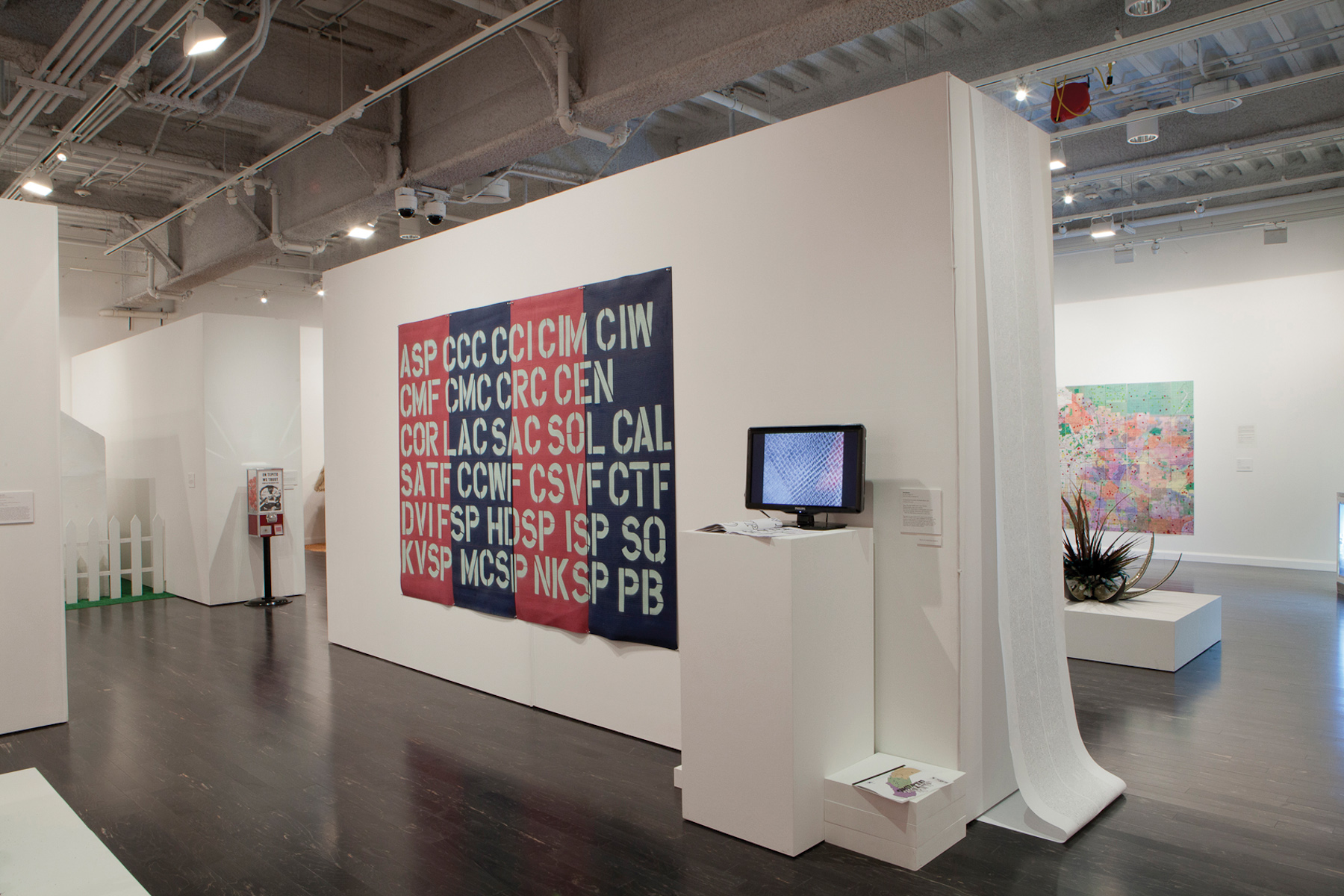
MexiCali Biennial 2013: Cannibalism in the New World, installation view, Vincent Price Museum of Art, January 19–April 13, 2013. Photo courtesy of Vincent Price Museum of Art.
Alvarado examines unseen places from a psychogeographer’s perspective in The People Movers (2012), an installation of video, sound, and digital drawings that describes parallels between California’s cartography and its incarceration facilities. Prisons are built away from roads and towns where they can be easily seen or accessed, thereby heightening the isolation of punishment and its deleterious effects on poor and immigrant communities. Avramescu details the evolution of penal philosophy from one of mitigating atrocity to one of non-lethal justice among authors of the nineteenth century, which follows medicalization of the executioner’s task through the introduction of the grimly efficient guillotine. The historical shift from execution to incarceration finds its origin in an intelligentsia shocked by the excesses of the aftermath of the French Revolution of 1789, which inspired fears of the common crowd as a mass of savages, capable of cannibalism and any number of tortures.8 Inspired by such anxieties and by the increased prominence of medical and biological science, Jeremy Bentham identified documenting and delineating spaces through architectural planning and through visual observation as effective tools for policing human behavior within those spaces. Bentham presciently described many aspects of the modern surveillance state and was a critic of natural law philosophy. He advocated for such policing measures as the only way to ensure that individuals would not resort to antisocial or cannibalistic behavior in public space. His ideas, which Foucault critiqued in Discipline and Punish, are foundational to the American penal system. As an interventionist artist, Alvarado subverts systems of observation and control that have evolved from Bentham’s model.
Juan Luna-Avin considers how culture and art move freely across both psychological and physical barriers. His untitled vending machine of 2012 distributes printed web links to pirated American and Mexican music he has obtained from street vendors and made available online. Luna-Avin obsessively collects black-market music, which he curates and distributes to art audiences. Cross-border Internet piracy exposes the American entertainment industry to threat, and so represents an unexpected power in the hands of the poor and developing nations. Los Angeles is a landscape wherein these entities meet. Like Alvarado, Luna-Avin is interested in questions of criminality and otherness, but more inclined to focus on the pleasurable rewards of subversive activities. Natural law theorists could account for cannibalism by necessity of survival or as an act of protest or revenge without deviating from their worldview, but were harder pressed to explain why some people chose anthropophagy for the taste. If corporations are people, as U.S. law currently allows, then Luna-Avin’s act of sly generosity promises new pleasures cut from the corpses of culture industry behemoths.
Cannibalism’s potency as a strategy for negating and redirecting the balance of power is apparent in Zoè Gruni’s sculpture Cannibal (2009). A ring of legs in compressed sawdust crowned by a thatch of blond hair, the work reflects the rampant consumption of both resources and culture in a global marketplace. Gruni, who works between Italy, Brazil, and Los Angeles, bridges the Neo-Concretist tradition with Arte Povera’s similar ethos by utilizing form and material in politically subversive ways. Her use of sawdust speaks to the havoc that logging has wrought on the climate of the Amazon rainforest and to ongoing tensions over land and resources in an interconnected and finite world. The blond thatch alludes to the international spread of Euro-American beauty standards, which are imported through media and mix with preexisting ethnic prejudices. Each culture has cannibalized the other: the developed world has consumed resources; the developing world has consumed fantasy. The result is a homogenous but fragmented structure, partly human but wholly unnatural.
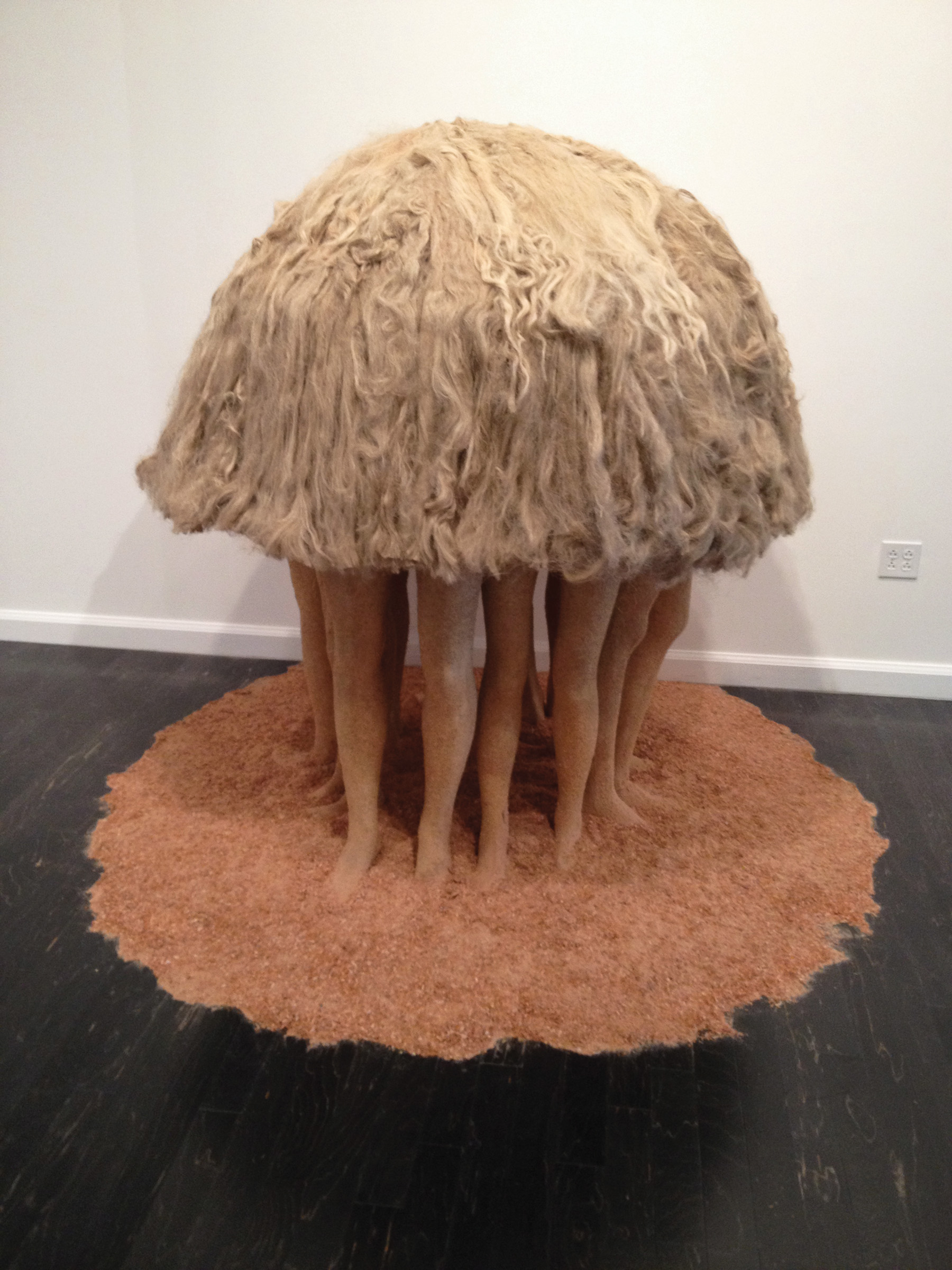
Zoè Gruni, Cannibal, 2009. Hemp, iron, foam, and sawdust. © Zoè Gruni. Courtesy of Fu Xin Gallery. Photo by Anuradha Vikram.
Los Angeles-based Candice Lin likewise engages with the Brazilian legacy of anthropophagy. On a recent residency in rural Brazil, she produced Whole New Animal (2012). The film, which incorporates stop-motion animation and found footage, is equal parts folktale and anthropological study. The protagonist is the transgendered caboclo, whose absence of clear male/female identification is paralleled by dual tribal and European lineage. Lin’s dreamlike sequences connect sexual violence with political violence done to indigenous people and devastation of natural resources, while locating revolutionary power in the children of that violence. Narration alternates between female and male voices, both speaking in the first person. Trusting, the caboclo is lured from his pastoral home by European soldiers who kidnap her as an anthropological curiosity and attempt violation. Vengeance is taken as a revolutionary strike against a colonizer whose insatiable urge for sexual and environmental exploitation is wedded to a desire to identify, objectify, and collect aberrant bodies. This archetypal hero/ine is described by Gayatri Chakravorty Spivak as “not-quite-not-man”9 and as evidence of how “the postcolonial negotiates with the structures of violence and violation that made her.”10 Initially, Lin’s caboclo is amoral, existing in a state of nature that owes more to Rousseau than to Hobbes. Forcibly brought into civil society, he escapes through an act of self-mutilation that denies the captors privilege to control the captive body. Through cannibal action, she becomes “the agent who would defeat this continuous narrative of exploitation.”11 This sacrifice breaks the cycle of dominance and submission that drives abuse of people and resources.
Andrade wrote, “What clashed with the truth was clothing, that raincoat placed between the inner and outer worlds. The reaction against the dressed man. American movies will inform us.”12 Identity in global contemporary art acts like clothing, as a membrane that renders the artist’s expression of inner life presentable to a socially constructed audience. Anthropophagy as an artistic strategy does away with that broad and impenetrable barrier, allowing for multiple points of contact. The artist’s position becomes ambiguous, unreliable, inauthentic, and liberated. Andrade’s reference to American movies reinforces the idea that the anthropophagus is an image of colonial anxiety, ripe for deconstruction. As he predicted, the cannibals have arisen, only fifteen miles east of Hollywood. Their synthesis of rhetoric and form represents a way forward for an art world that is sated on identity politics and academic conceptualism, and ready to cough up something new.
Anuradha Vikram is a San Francisco Bay Area-based independent scholar who has curated exhibitions for the Craft and Folk Art Museum, Los Angeles; Mills College Art Museum, Oakland; DeYoung Artists Studio, San Francisco; and Worth Ryder Art Gallery, Department of Art Practice, UC Berkeley, as well as numerous Bay Area non-profits. She is a contributor to Artillery, Art Practical, Daily Serving, and OPEN SPACE—SFMOMA Blog, and has also been published in LEONARDO, Afterimage, SF Camerawork Journal, exhibition catalogs, and artist monographs.
